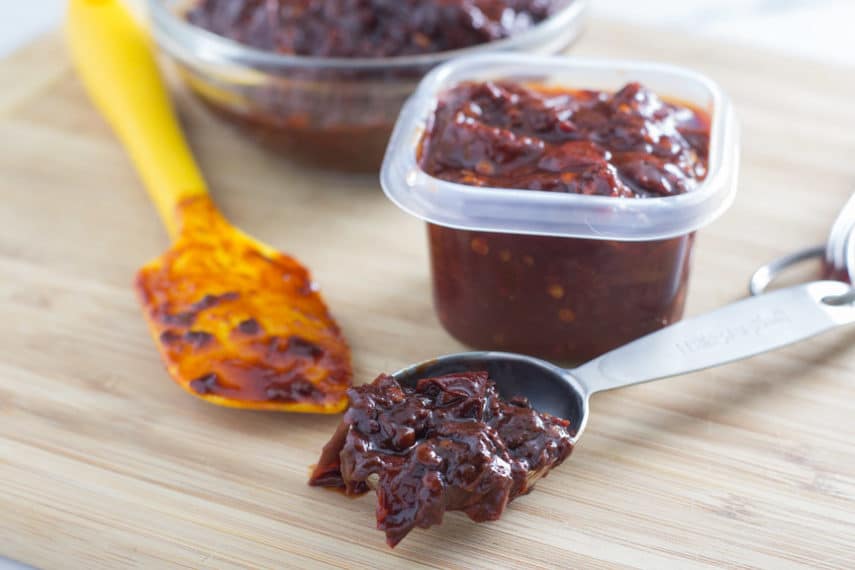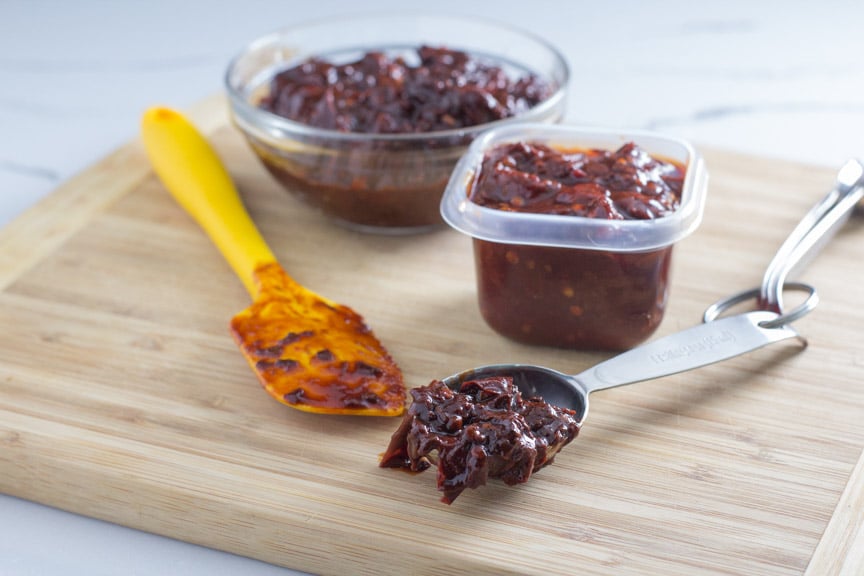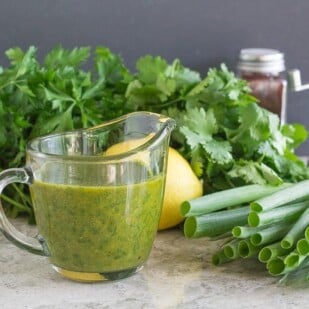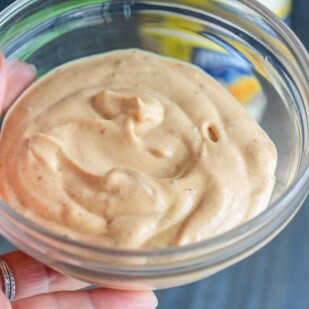Chipotle Chiles in Adobo Sauce is a Versatile Pantry Item Must Have!
One pantry item that I always used to keep on hand was cans of chipotle chiles in adobe sauce. The spicy flavor packed condiment added depth to everything from mayonnaise to barbecue sauce, glazes and marinades. But they contain garlic!
I had even been known to whisk a little into salsa or ketchup and my morning scrambled eggs. I’ve got great news – no need to go without – here is our recipe for Low FODMAP Chipotle Chiles in Adobo Sauce.
What Are Chipotle Peppers?
Chipotle peppers are dried, smoked jalapenos.
What Are Chipotle Peppers In Adobo Sauce?
Chipotle in adobo sauce takes those dried chiles, re-hydrates them and cooks them in a tangy, vinegary, spicy tomato sauce.
Is Purchased Chipotle In Adobo Sauce Low FODMAP?
The problem is that the purchased version of chipotles in adobo sauce contains garlic, so all of a sudden it was off limits to those following the Elimination Phase (and maybe beyond) of low FODMAP diet. It took me a while to even think about making my own because I assumed it would be hard.
Assumptions Are Dangerous
And assumptions can keep you from experiencing deliciousness! Guess what? I was so wrong. Not only is it easy to make this spicy, tangy staple but you can also freeze batches so that you never are without this incredibly versatile condiment.
But let’s talk a bit more about assumptions and extrapolations.
When Kate Scarlata RDN and I were writing our book, The Low-FODMAP Diet Step by Step, we felt confident that working with these peppers in this way was worth a try – particularly because what you end up ingesting PER SERVING is quite small.
In addition, there are lab tested and certified low FODMAP products, such as Smoke ‘n Sanity SnS Triple S Seasoning that contain chipotle, so we do know that there is a small low FODMAP serving.
Subsequently, Monash lab tested dried chipotle peppers and they state that 3 g is Moderate in FODMAPs.
Ultimately, the amount of chipotle in each serving of our recipe will be very small. This recipe yields 40 tablespoons worth of Chipotle Chiles in Adobo Sauce and contains 55 g of chipotle peppers. 55 g divided by 3 g is 18.3 portions. We have set our serving size as 40 portions.
Our best advice is to try this recipe when you are stable and in your Challenge Phase, if you tolerate spicy food well, and assess your own tolerance.
That said, we have not made this recipe “Elimination” icon worthy, as we want you to be cautious.
For all you chile lovers, be sure to check out our article All About Chile, Chili & Chilli & The Low FODMAP Diet.
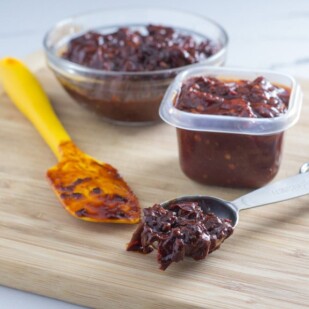
Chipotle Chiles in Adobo Sauce
Chipotle Chiles in Adobo Sauce are actually easy to make at home. We suggest a big batch so that you can freeze small portions.
Low FODMAP Serving Size Info: Makes 2 ½ cups (600 ml); 40 servings; serving size 1 tablespoon
Ingredients:
- 2 ounces (55 g) dried chipotle peppers (about 20 to 30 medium sized)
- Boiling water
- 2 1/2 cups (600 ml) canned tomato purée, such as Muir Glen or Pomi Organic Strained Tomatoes, divided (see Tips)
- 1/3 cup (27 g) finely chopped leeks, green parts only
- 1/3 cup (27 g) finely chopped scallions, green parts only
- 2/3 cup (165 ml) distilled white vinegar or apple cider vinegar
- 1 tablespoon sugar
- 1 teaspoon freshly ground black pepper
- 1 teaspoon kosher salt
Preparation:
-
Remove any stems from the chipotles and discard; there might not be any. Place the chiles in a heatproof bowl and cover with boiling water. Cover with a plate, large lid or even tightly with plastic wrap and allow to sit for about 20 minutes or until chiles are rehydrated, soft and pliable. Drain, discarding the water.
-
Place half of the chiles in a blender (just eyeball it) along with half of the tomato product, and all of the leeks, scallions, vinegar, sugar, pepper and salt. Blend until smooth.
-
Scrape blended mixture into medium-sized heavy bottom pot and add reserved tomato product. Roughly chop the remaining chiles by hand and add them to the pot making sure to include any juice, seeds, and skin.
-
Bring to a simmer over medium high heat, stirring often. Adjust heat, cover and cook at a low simmer for 45 minutes to 1 hour, checking and stirring occasionally. Cook until mixture has thickened a bit. The sauce might also darken a little bit, which is fine. If it overly dries out during cooking, simply add a little water.
-
Cool completely then divide into small airtight containers (we like ¼ cup (60 ml) portions). Refrigerate for up to 1 month or freeze for up to 6 months. Give these to your FODMAP friends! They will love you for it.
Notes:
Tips
- We absolutely love Pomi Organic Strained Tomatoes. They come in a shelf stable aseptic box and have one ingredient: tomatoes! If you have some of these on hand you will always be ready for tomato-based sauces at any time of year.
- Look for chipotle chiles in the bulk department of natural foods stores or mail-order for best economy.
If You Can Tolerate
- Fructans: If you have passed the garlic fructan Challenge add up to 8 minced garlic cloves to the sauce with the rest of the ingredients before cooking. That is a lot of garlic but you will typically only be eating a max of a tablespoon at a time of the finished product. As always, gauge your digestive response.
Nutrition
All nutritional information is based on third-party calculations and should be considered estimates. Actual nutritional content will vary with brands used, measuring methods, portion sizes and more. For a more detailed explanation, please read our article Understanding The Nutrition Panel Within Our Recipes.
